What would a Canadian newsstand have looked like in terms of comic books during the summer of 1941? Well, there would have been a dearth of them to begin with because the war-time government ban on the importation of almost all American comics had sapped the floppy four-colour vitality out of them. No Shuster Superman, no Simon and Kirby Cap, no Bob Kane Batman, and no C. C. Beck Big Red Cheese.
Those comics that were there must have been tucked away somewhere among the grown up magazines, race forms, newspapers and almanacs. Maple Leaf’s Better Comics had had a half-dozen issues out by the summer of 1941 and Anglo-American’s Robin Hood Comics, being a bi-monthly book, would have been up to issue three. The third issue of Maple Leaf’s Lucky Comics, with the first appearance of its eponymous eight-year-old French orphan starting life under German occupation, would also have been there. There would even have been a couple of ‘educational-type’ American comics such as Real Heroes and True Comics, which were allowed through the Comic Iron Curtain along the 49th parallel. You could probably even find a Spirit Section tucked into one or two of the newspapers if you looked hard enough, but I’m not sure you could count them as comic books proper.
There’s even a good chance that Freelance Comics No. 1 (July-August 1941), Triumph-Adventure Comics No. 1 (August 1941), and Wow Comics No. 1 (September 1941) could have been side by side on the same newsstand row. What a picture that makes.
1941 was the formative year for Canadian comic books. They were embryonic and evolving. I don’t think anybody knew at this point what form they would eventually take on. Finding any Canadian comics from this eariest year is a difficult task for collectors.
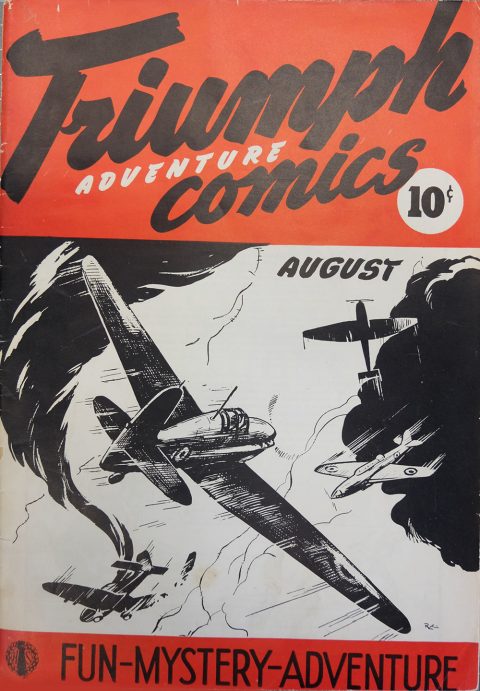
In this column I want to write about one of the hardest WECA sets to complete: the six-issue run of Hillborough Studio’s Triumph-Adventure Comics. The first issue of this set is probably THE key book of the whole Canadian golden age comics cycle because of the first appearance of Adrian Dingle’s Canadian comic book icon Nelvana of the Northern Lights. The Bell Features Nelvana compendium that came out four years later has been the highest WECA achiever on internet auctions by tipping the scales at just over $16K US. I only know of half-a-dozen extant copies of Triumph-Adventure Comics No. 1 (compare this with the approximately 70 or so slabbed copies of Action Comics No. 1) but if one of these, or a newly discovered one, came onto the market, I’m sure it would crash through this monetary ceiling quite easily.
Triumph-Adventure Comics was born in the heart of a war-time Toronto art enclave on Grenville Street. Though Grenville was just three blocks long, it was packed with studios and galleries populated by sculptors, dancers, musicians, actors, and artists, with Malloney’s bar stuck in the middle somewhere. This short street extended west from Yonge just a block above College and Hillborough Studio was at number 64, a couple of doors west of Bay on the south side. Franz Johnston, who brought back the Nelvana myth from the Arctic to Dingle had his studio there and the Kulbach twins lived at No. 16. Today, Grenville has been hit hard by the condo virus that has infected most of the city, but I’d like to think that there might have been one or two chestnut trees in that area back then. Here is an account of Grenville Street from Frank Chamberlain’s column from the November 21, 1944 edition of The Globe and Mail:
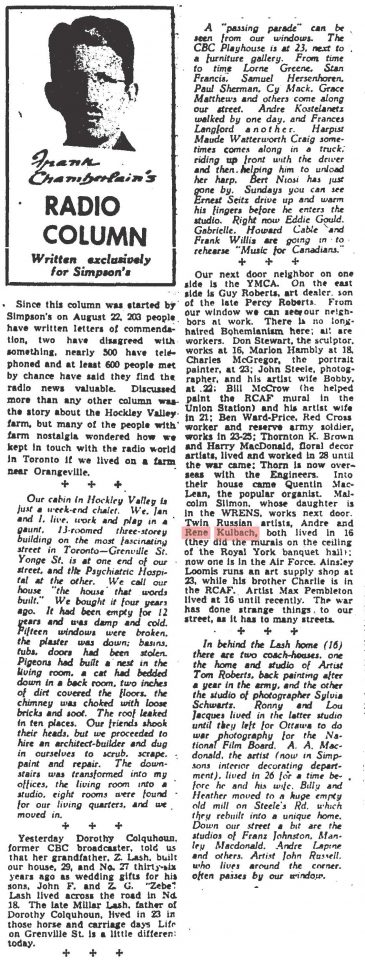
Triumph-Adventure Comics No. 1 was the product of the vision of three fine artists, Adrian Dingle and Rene and Andre Kulbach, as well as some financial backing by a third unrecorded individual. The past years of The Great Depression and the years of international war that followed provided little monetary scope for artists in Canada and the window of opportunity offered up by the government ban on American comics was to good to disregard. Just as with Vernon Miller and the first Canadian comic book, Maple Leaf’s Better Comics Vol. 1 No. 1, Adrian Dingle, as Editor, put out some very noble motives and aspirations for a 10-cent floppy that kids would roll up and stick in their back pocket. Just over a year later, Harry Halperin would take them even further in his first issue of Canadian Heroes Comics for Educational Projects. Here is the inside front cover for that first issue of Triumph-Adventure Comics:
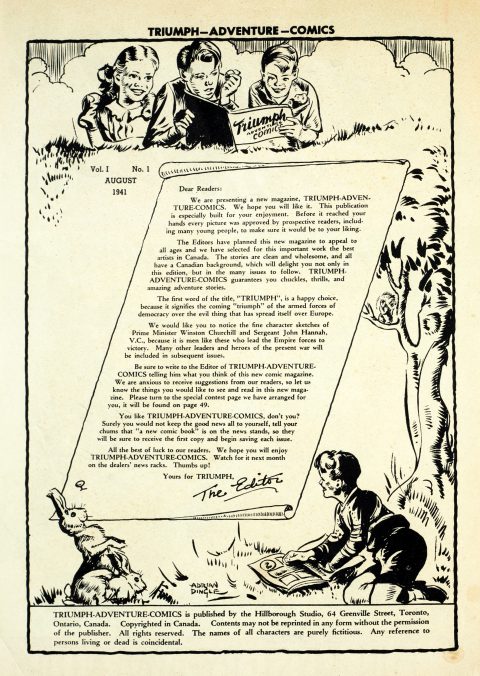
I wonder if proclamations like this introduced many comparable first issues of American golden age books?
Dingle chose to lead off this first issue of the title with a military espionage feature about an air ace, named ‘Spanner’ Preston who is recruited by WWII British Intelligence. ‘Spanner,’ to Brits, is a word for ‘wrench’ and Mr. Preston will soon become a ‘wrench’ in the military plans of the Axis. The story is written by H. B. Ohrt and drawn by Leon James, but little else is known about them or how Dingle managed to recruit them for the comic. The splash page opens during the evacuation of Dunkirk which had occurred just over a year before the comic came out. ‘Spanner’ is the leader of a squadron flying cover for the British (like the Tom Hardy role in the movie “Dunkirk,”) but his plane is knocked out of the air behind enemy lines. He eventually makes his way back to friendly Dover shores and rescues a wounded British major on the way. His exploits come to the attention of British Intelligence and he is recruited into their service.
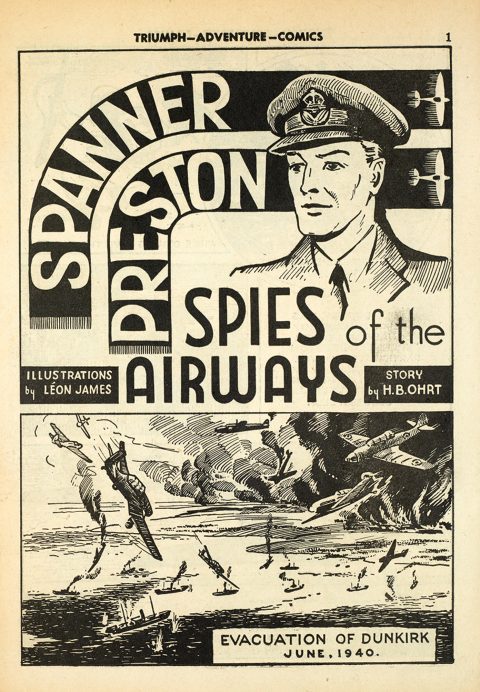
Dingle also chose Rene Kulbach to illustrate the cover of Triumph-Adventure 1 with a depiction of ‘Spanner’s’ plane in action. Dingle must have felt that, given the explanation of the title of the comic in the statement on the inside cover, and the fact that the country was at war, the military theme on the cover and in the lead off story were best. The feature ran, written and drawn by the same creators, for the six-issue run of Triumph-Adventure Comics, though the credits disappeared in the final issue. In his second appearance in issue 2, it’s made clear that ‘Spanner’ is a young Canadian pilot operating within the RAF. This may have been a editorial adjustment after the first issue.
The next feature is why this comic book has a shining star on the Canadian comic book collectors walk of fame. It is, of course, Nelvana of the Northern Lights. I’ve written about this demi-goddess before here and needn’t go over that material again. Suffice it to say that this fantasy of a half-Inuit, half-goddess of the aurora borealis, is what Adrian Dingle has been remembered for within Canadian comic book circles. Nelvana has had one of Canada’s biggest animation studios named after her and she has become an emblematic totem for everything Canadian in comic books. Her feature lasted all six issues of Triumph-Adventure Comics and is one of the two that eventually made a seamless transition to Bell Features.
After “Nelvana” in this first issue of Triumph-Adventure Comics we encounter “Clue Catchers” which involved the crime investigating adventures of Chief Inspector Patrick Malloy and his kids, Chip, a boy in his early teenage years, and an older daughter, Judy, who ‘takes care of the household.’ The family’s absent mother is never explained but the assumption is that Inspector Malloy is a widower. The feature is notable for seeing if the reader can find the clues that lead to the solution for the crime that was committed and only revealing the links in a half-page addendum after the final panel of the story.
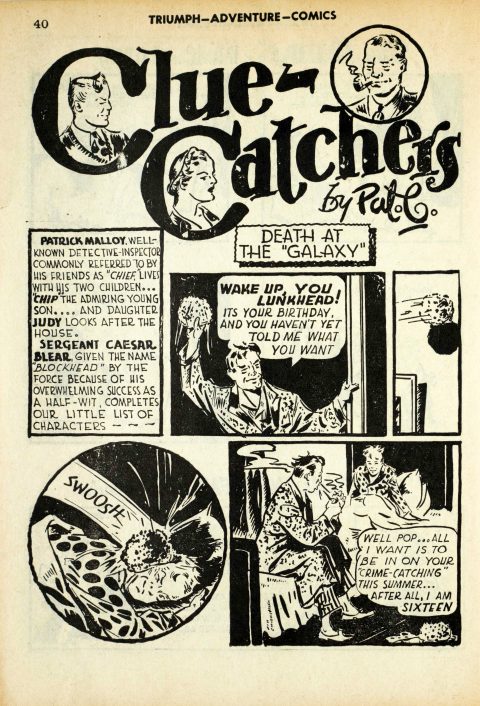
The last feature in this first issue of Triumph-Adventure Comics was the western “Tang.” This was illustrated by Rene Kulbach for all six issues of the title, but the first four installments were written by Frank Brookwood and the last two by H. B. Ohrt who also wrote the Spanner Preston feature. But, just like Ohrt, nothing is really known about Frank Brookwood.
This was written by Patricia Neville Symmes under the pen name ‘Pat C.’ She was Adrian Dingle’s fiancée at the time and part of the reason for starting up this comic book enterprise was to help finance their upcoming wedding which would take place in December. “Clue Catchers” ran for the entire run of Triumph-Adventure and ‘Pat C.’ continued to do some spot writing for Bell Features after the Hillborough book folded.
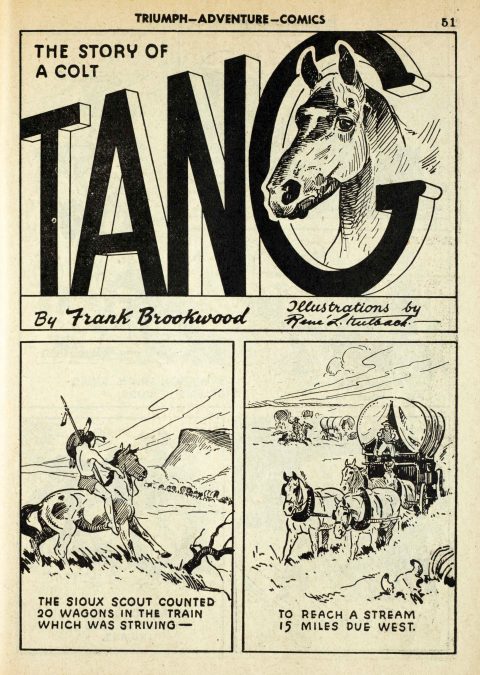
The story is about young ten-year-old Buddy Breckenridge who, with his adopted sister, is kidnapped by plains Indians. They subsequently escape and, by the fifth issue of the title, they meet up with the wild colt who they name “Tang” and Buddy and the horse bond. The children are taken in by a foster family and after a few years Buddy, with the help of Tang, becomes a skillful pony express rider.
“Tang” along with “Nelvana of the Northern Lights” were the two features that transitioned from Hillborough Studio to Bell Features except that with Tang the writers didn’t come along. Rene Kulbach took over the writing duties as well as drawing the feature for Cy Bell’s comics. Kulbach always had a tremendous interest in and love for animals and this comes through in his artful rendering of horses in his “Tang” and “Phantom Rider” stories. This is also evident in his playful design of the cartoony creatures of his “Out of the Woods” filler in the six-issue run of Triumph-Adventure Comics. Now, the “Out of the Woods” filler eventually also made the transition to Bell Features as a full feature and even earned a cover on Dime Comics No. 25.
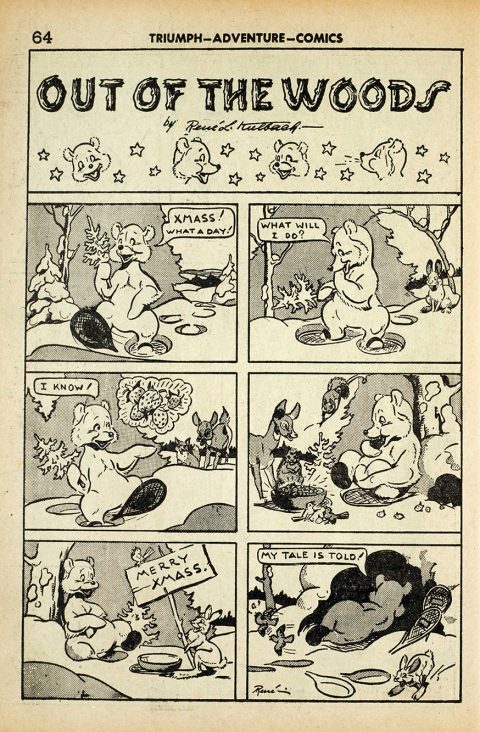
Besides the one-page “Out of the Woods” filler by Rene Kulbach, the six-issue run of Triumph-Adventure Comics also had Dingle’s filler “The Mums” and a small filler strip by Andre Kulbach called “Unusual Incidents.”
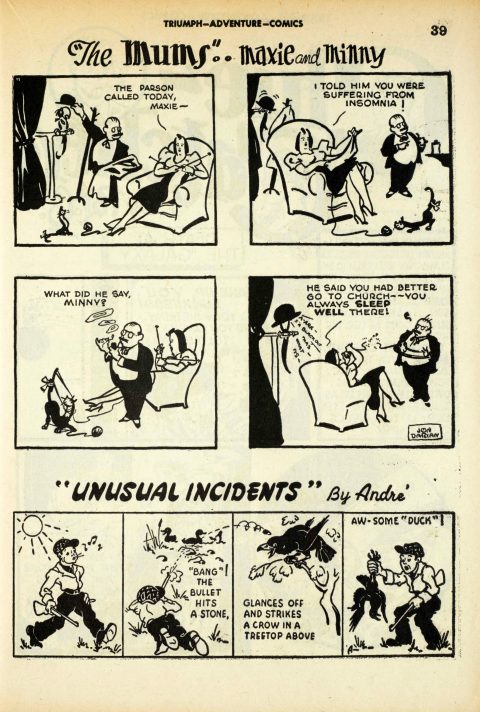
In terms of fillers, the highlights of each issue were Adrian Dingle’s full-page portraits of statesmen and war heroes. Remember that Dingle had made his name as an accomplished portrait painter before the idea of comics ever entered his head. Here is his portrait sketch of Winston Churchill from Triumph-Adventure Comics No. 1:
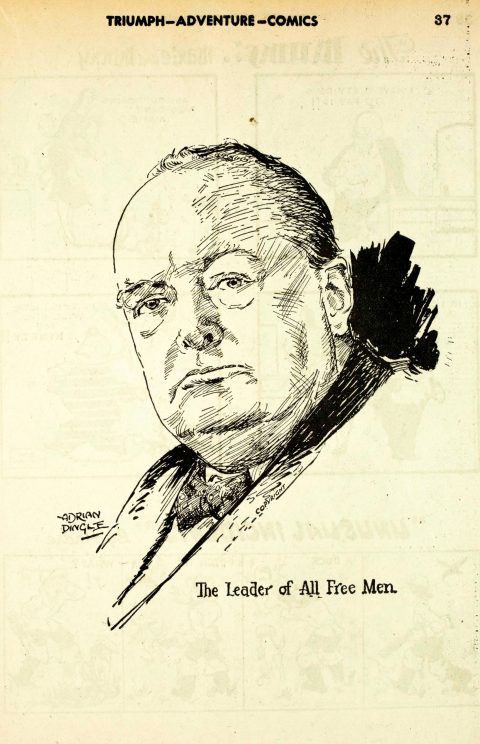
The second issue of Triumph-Adventure Comics introduced a new character and feature called “Derek Bras d’Or” about a literally larger-than-life Cape Breton young man whose stature and exploits were based on a real life giant named Angus MacAskill. This feature was written by Glen Guest and illustrated by A. L. Alexander about whom we have no further information and it ran for the remaining issues of Triumph-Adventure Comics.
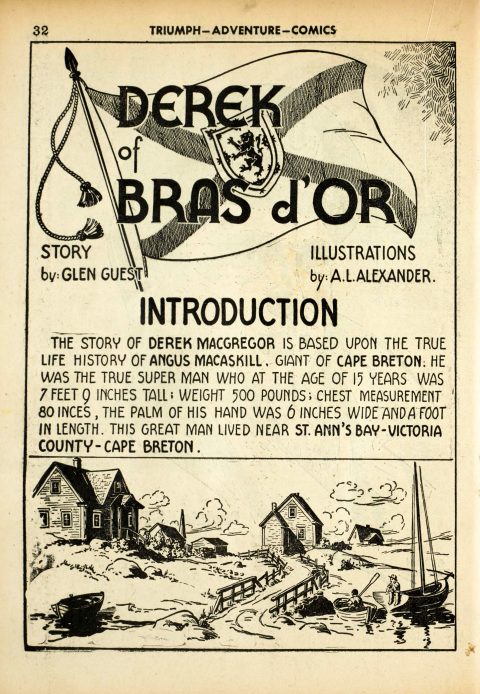
We have to wait until Triumph-Adventure No. 5 before the next new feature is introduced. It was called “Escape.” and related the story of young Norwegian resistance fighters who escape to England and then eventually to Canada, where they joined the Norwegian Air Force in training to fight again in Europe. The story is based on the historical fact that the Norwegian Air Force did, indeed, receive Canadian training on Toronto Island and even set up a kind of colony at the foot of Bathurst St. called ‘Little Norway.’ This two-part feature was written and drawn by fine artist Hugh (H. B.) Caulfield who also did the “Happy Holden” feature in the one-shot Top-Flight Comics that Hillborough Studio put out at the start of 1942.
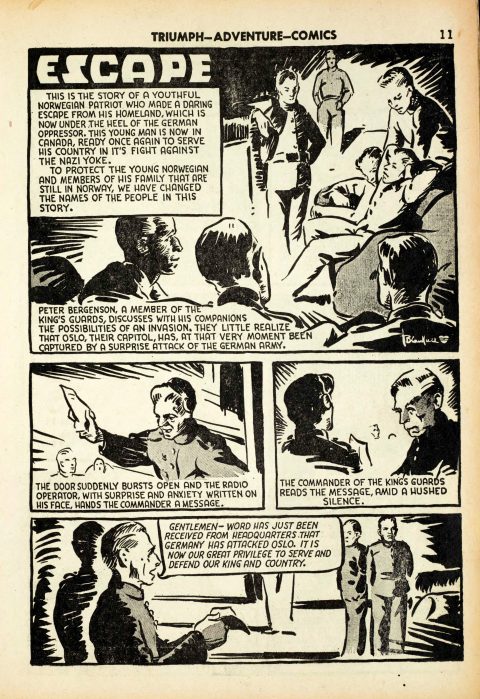
Caulfield also wrote a new feature for the last issue of Triumph-Adventure Comics called “Commandos” which is the offers the beginnings to the story of a British young man who wishes to join the Commando forces fighting in Europe.
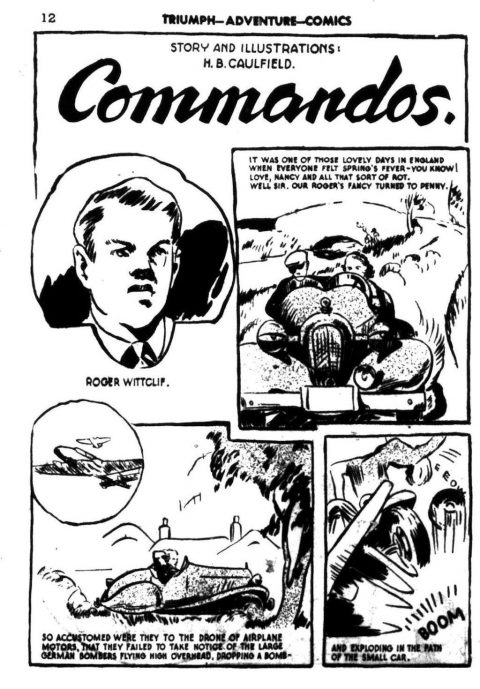
During the six-issue run of the title Dingle juggled the order of the features in each issue, moving each of the features, in turn, up to the front of the comic and then putting that feature on the front cover.
So we have ‘Spanner’ Preston’s plane in a dogfight on the cover of the first issue then Nelvana on the cover of issue two, fighting horses from “Tang” on issue three, Derek Bras d’Or in a life and death struggle with a swordfish on issue four, and Chip Malloy from slugging a Nazi operative on the front cover of issue five. Issue six reverts to a panel from the ‘Spanner’ Preston story that is enhanced for its appearance on front cover. We must also note that the word “Adventure” is removed from the masthead for issues five and six though it still sticks in the indicia for these books.
The last issue of Triumph-Adventure Comics was cover-dated February 1942. The first issue of Hillborough’s new title, Top-Flight Comics also bore the same cover date. Across town, Anglo-American was getting into its redraws of Fawcett scripts, Cy Bell was beginning to expand his title line up from just Wow Comics with first issues of his new titles Active Comics and Dime Comics. Out on the west coast, Maple Leaf Publications were beginning to put out its fourth title Rocket Comics. Dingle and Hillborough Studio, however, succumbed to an accumulation of debts that could not be overcome, and those February issues were the last to be produced.
Luckily, Cy Bell contacted Dingle and was prepared to take care of Hillborough’s debts as well as hire Dingle as Bell Features new Art Director. Bell’s Triumph Comics No. 7 probably appeared on the stands by about May 1942 with Nelvana battling Hitler on the cover and a Nelvana and Tang story by Rene Kulbach inside.
As I said before, this six-issue run of Hillborough Triumph-Adventure Comics is virtually impossible to complete. If you can find a single issue, even a coverless one, count yourself lucky but the run of Triumph-Adventure Comics, the product of a little start-up comic company in an art enclave just a few blocks away from Maple Leaf Gardens, was one of the most important in Canadian comics history.
Before closing, I’d like to draw your attention to the inside back cover of Triumph Adventure Comics No. 5. This is not unlike other polls that many of the Canadian publishers had to test readership interest but notice what you got for simply filling in the boxes and sending them into the publisher. I wonder how many of these original drawings were claimed and how many of them still exist and are waiting to be found!
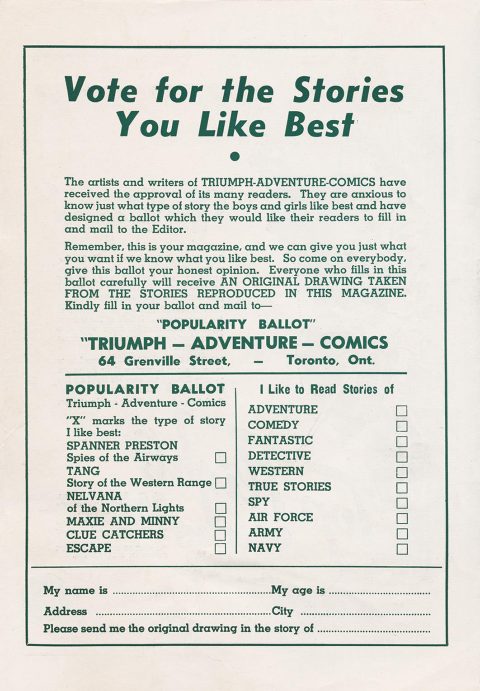

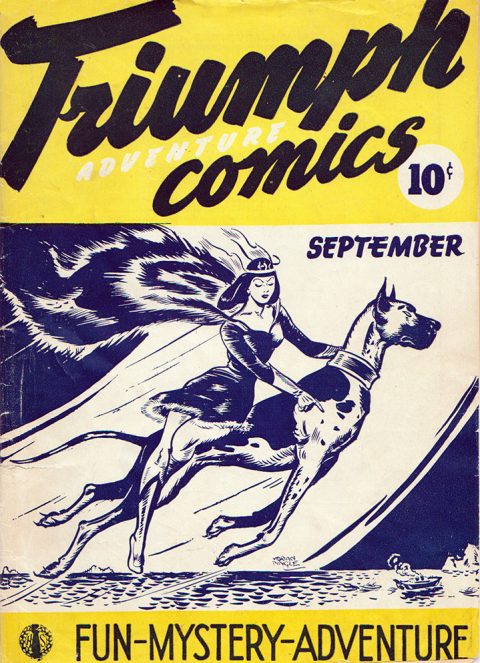
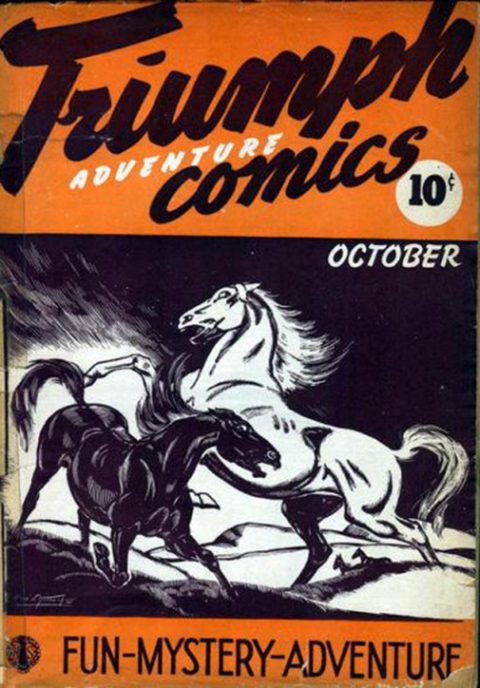
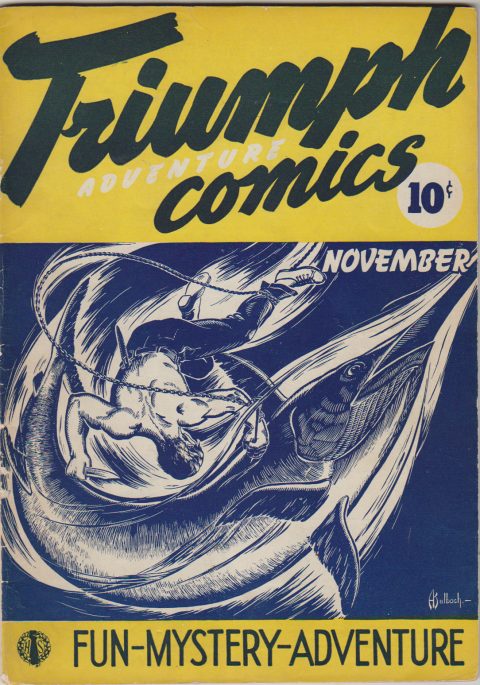
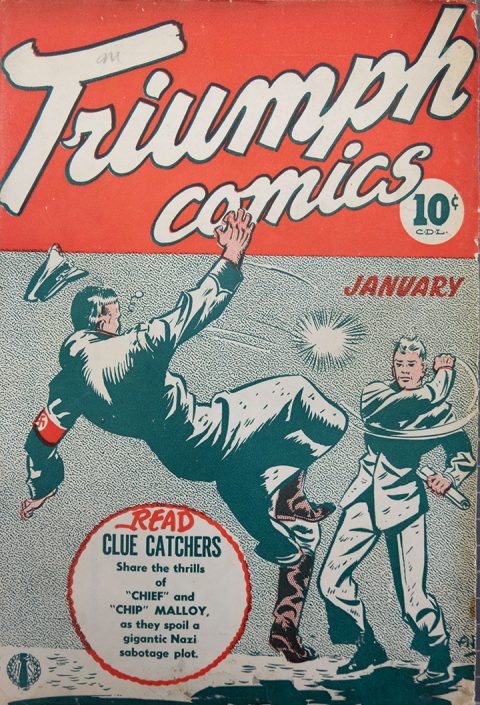
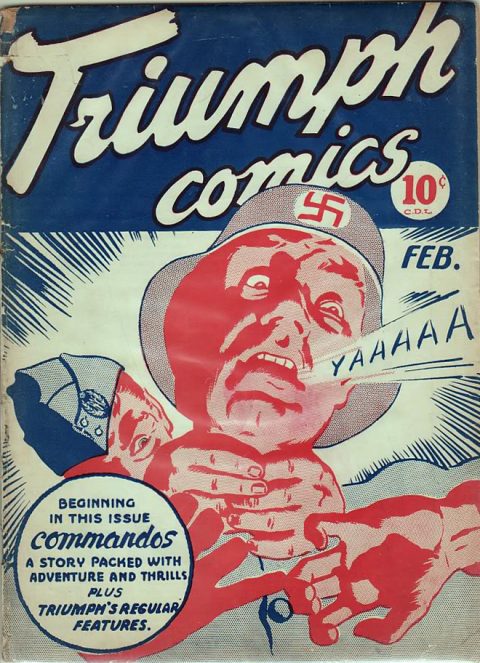
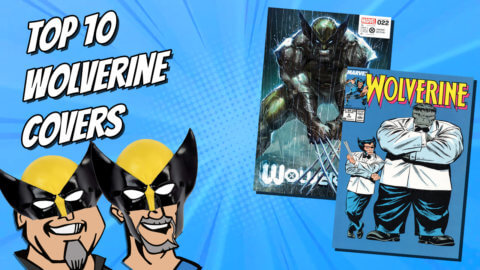

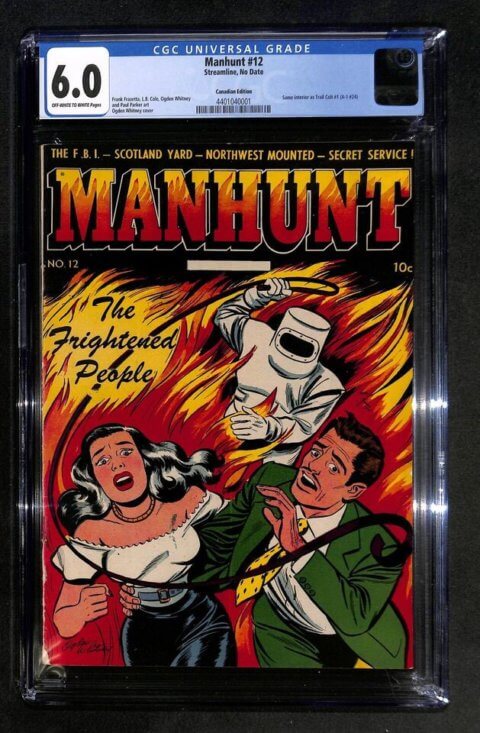
another great read , Ivan ! keep them coming ! btw , last week I received from bud plant my copy of the signed heroes of the home front , number 36 ! a fabulous book , you should be very proud of this book ! will we see you do one on say Maple Leaf , etc ?
Very informative. I concur that it is virtually impossible to completed an entire run of Triumph-Adventure Comics # 1-6.
As a collector of Canadian WECA books for almost 2 decades, I have been fortunate enough to possess Triumph-Adventure Comics # 1-4 and # 6.
I am seeking a copy of TA # 5 but so far to no avail.
Simply put, these books are as tough as nails. The National Library and Archives Canada does NOT even possess a copy of TA # 3 accordingly to Hope Nicholson and Rachel Ritchie.
Thanks for this, Ivan. It is wonderful to have a chance to learn about the interiors of these books, given that I may not ever have a chance to see them in person.
There is a copy of TA5 on ebay.ca by somebody called brunom450 but he wants a lot for it. It would complete your collection though.
Chris, thanks for picking up my book and thanks very much for the positive comments on it. It had a print run of 450 copies and 110 were signed and numbered. I have about 50 copies left and am doing my best to get it into libraries around the area but it’s a hard slog. Right now I’ve managed to get about a dozen copies into places like OCAD, Toronto Reference Library, Hamilton Public Library, Ryerson University Library, Wester University Library, London Pubic Library, Windsor Public Library, etc. More to come I hope. Maple Leaf Publications are not low hanging fruit when it comes to Canadian comic research. There is so little info out there and you would silly to do it without being in BC. I know that Ken Boesem, who lives in Vancouver, has been working on something. I am thinking of doing a Gerber-style photo-journal of all the WECA comic book covers as a next project since that’s a more reasonable and reachable goal.
Stephen, If I recall from my visits to the Library and Archives in Ottawa, they only have Triumph-Adventure Comics Nos. 1, 2, and 5 but they have two copies of each. Here is a link to the digitized versions of their collection: http://amicus.collectionscanada.gc.ca/aaweb-bin/aamain/itemdisp?sessionKey=999999999_142&itm=43040531&l=0&d=2&v=0&av=1&lvl=1 .
Brian, check out the link in my response to Stephen since it gives you the contents of half the run.
Thanks, Ivan. I will check out the link. I know that if I lived in Ottawa I would be making regular trips to the LAC!
Thank you so much Ivan for the link.
4.5
Another great article. I never made the connection between the covers and rotating the characters. I never saw the planes as Spanners plane. Just more as a generic plane.
looking forward to more articles.
Thanks for your positive comments, Peter. I had thought as you did that the planes on the cover of Triumph-Adventure Comics 1 were just generic war icons. It wasn’t until I had read the 6 books in the run from cover to cover for this article, that I twigged to the connection between their covers and the rotating lead features. This makes me think of how difficult it is to do articles on Maple Leaf books because there is no exhaustive repository. I think it should be a Canadian cultural imperative for us to put together some sort of publicly accessible comprehensive collection of all the WECA era comics. It’s been done for the Bell Features books. Now we need it for the Educational Projects, Anglo-American, and especially those hens-teeth Maple Leaf comics.
hello Ivan! My search for more Canadian comics (after the Nelvana, Brok and Johnny Canuck recent books) led me here. I’m so late to this party but it appears fabulous, I’ll be spending many hours here and on the Canada’s Own Comics website. Maybe some posts about your new project once I read up on it.
For the moment though re: Heroes of the Home Front book. Yeah, I missed that boat (sorry) and while I hope you sold out your print run, I’m also hoping you have some copies left. I’d really like to buy one! Please let me know and if I can Paypal you. Thank you. Contact me via my email if possible.
I’m 67 this weekend, and for some reason going back in time to read things produced before my time, means something. And I want more than US heroes.
Cheers!
Tim, I know what you mean. I turned 68 a couple of weeks ago and still wonder why I decided to look into these old war-time Canadian comics as a retirement project. I guess there seems to be more comic magic for me in these old Canuck books than the American ones. Still have a few of the Heroes books and the Price Guide/Checklist left if you need on. I don’t have your email address but you can contact me at [email protected] .
Ivan, terrific! and thanks. You’ll be hearing from me in a few minutes.